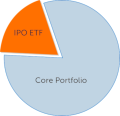
Blank check company Silver Run Acquisition (SRAQU) made headlines in the IPO market - partly because little else could - as it completed the year's largest "IPO" in an upsized $450 million offering. That's 13% more capital raised than the combined total from the four IPOs to date, and enough to make Silver Run the 7th-largest SPAC of the past 100.
With a resurgence of special purpose acquisition companies (SPACs) in the IPO market underway, here are six facts about SPACs.
1. With SPACs you bet the jockey, not the horse (there is no horse)

Investors in Silver Run Acquisition are placing a bet on industry veteran Mark Papa's ability to identify a strong oil and gas E&P at an attractive price. SPAC investors have no business to analyze, no financials to assess - only trust in a CEO with a track record for returning value to shareholders.
2. SPAC offerings surged last year, even as broader IPO activity declined
Even as IPO activity in 2015 declined 38% and proceeds fell 65% over the prior year, blank check IPOs rose 82% and proceeds jumped 132%. Last year was the most active for SPAC IPOs since 2007's record-setting spike. Because SPACs typically fund their acquisitions with debt, it makes sense to go public when interest rates are low.
3. Five underwriters dominate blank check distribution
Every SPAC IPO since 2014 has been led by one of five underwriters: Deutsche Bank (9), EarlyBird Capital (8), Citi (7), Cantor Fitzgerald (6) and UBS (2).
4. Blank checks price at $10 and list on the Nasdaq

Since 2013, every SPAC has priced at $10 per unit. In most cases, buyers of the IPO obtain a warrant with their shares, which eventually begin trading on their own. All SPACs in the past three years have listed on the Nasdaq.
5. Blank checks: An IPO where risk is low (at first)
SPACs typically trade in a tight range - the 20 from last year have a total return of +/- 3%. After all, they simply hold cash in a trust until an acquisition. Sophisticated fund managers can park their capital in equity that is liquid, stable, and interest-earning. Investors also have the option of cashing out before an acquisition is made. This past week's Silver Run IPO gained 2% on its first day, while the two most recent ordinary IPOs - AveXis (AVXS) and Proteostasis (PTI) - fell 10% and 17% on their debuts, respectively.
6. SPACs all over the map: Companies target various geographies and sectors
Silver Run and the upcoming KLR Energy (KLREU) IPO are pitched as a play on distressed oil and gas assets, but SPACs from the past two years have not been concentrated on any one trend. Their focus includes various sectors such as financial services, energy, telecom, tech and materials, as well as areas like China and South America.


